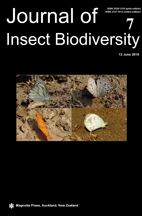Abstract
Ooceraea quadridentata sp. nov. is described based on a colony series collected from a disturbed and bamboo-mixed evergreen forest in Vietnam’s Central Highlands (Nam Kar Nature Reserve, Dak Lak Province). This new species is distinguished from other described congeners by its propodeum with two pairs of conspicuous denticles. This represents the second species of the genus Ooceraea from the Indo-Chinese Peninsula. A preliminary key to Oriental species of Ooceraea based on the worker caste is also provided.
References
AntWeb. Available from https://www.antweb.org/ (Accessed 10 Mar. 2018)
Antmaps. Available from https://antmaps.org/ (Accessed 10 Mar. 2018)
Bolton B. 2018. An online catalog of the ants of the world. Available from http://antcat.org/ (Accessed 10 Mar. 2018)
Borowiec M. L. 2016. Generic revision of the ant subfamily Dorylinae (Hymenoptera, Formicidae). ZooKeys 608: 1–280.
https://doi.org/10.3897/zookeys.608.9427
Brown W. L. Jr. 1975. Contributions toward a reclassification of the Formicidae. V. Ponerinae, tribes Platythyreini, Cerapachyini, Cylindromyrmecini, Acanthostichini, and Aenictogitini. Search Agriculture (Ithaca, New York) 5(1): 1–115.
Emery C. 1902. Note mirmecologiche. Rendiconti delle Sessioni della Reale Accademia delle Scienze dell’Istituto di Bologna (n.s.) 6: 22–34.
Emery C. 1911. Hymenoptera. Fam. Formicidae. Subfam. Ponerinae. Genera Insectorum 118: 1–125.
Holt B, Lessard J. P., Borregaard M. K., Fritz S. A., Araujo M. B., Dimitrov D., Fabre P. H., Graham C. H., Graves G. R., Jonsson K. A., Nogues-Bravo D., Wang Z. H., Whittaker R. J., Fjeldsa J. & Rahbek C. 2013. An update of Wallace’s zoogeographic regions of the world. Science 339(6115): 74–78.
https://doi.org/10.1126/science.1228282
Janicki J. H., Narula, N., Ziegler M., Guénard B. & Economo E. P. 2016. Visualizing and interacting with large-volume biodiversity data using client-server web mapping applications: the design and implementation of antmaps.org. Ecological Informatics 32: 185–193.
Roger J. 1862. Einige neue exotische Ameisen-Gattungen und Arten. Berliner entomologische Zeitschrift 6: 233–254.
Tsuji K. & Yamauchi K. 1995. Production of females by parthenogenesis in the ant, Cerapachys biroi. Insectes Sociaux
42(3): 333–336.https://doi.org/10.1007/BF01240430
Wetterer J. K., Kronauer D. J. & Borowiec M. L. 2012. Worldwide spread of Cerapachys biroi (Hymenoptera: Formicidae: Cerapachyinae). Myrmecological News 17: 1–4.
Yamada A. & Eguchi K. 2016. Description of the male genitalia of Pristomyrmex punctatus (Smith, 1860) (Hymenoptera, Formicidae, Myrmicinae). Asian Myrmecology 8: 87–94.

